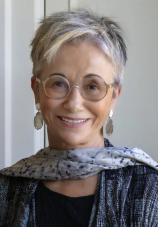What Came Before He Shot Her
Review
What Came Before He Shot Her
"A wanton act of destruction" --- no, not a murder as such, but the
way one of Elizabeth George's outraged readers described the
unhappy ending of WITH NO ONE AS WITNESS, her second-to-last book:
Helen, the adored pregnant wife of George's policeman hero,
Detective Inspector Thomas Lynley, is gunned down on the doorstep
of her London house. Mystery lovers are often habituated to tidy,
let-justice-be-done denouements; sacrificing Lynley's nearest and
dearest evidently violated some unspoken taboo.
When Arthur Conan Doyle killed off Sherlock Holmes (he was weary of
turning out stories about the eccentric detective), his admirers
were so upset that he had to bring Holmes back from the dead.
George, in contrast, doesn't seem inclined to appease her fans:
Instead, she takes an even bigger chance in her new book, WHAT CAME
BEFORE HE SHOT HER, telling the story behind Mrs. Lynley's
murder.
The apparent culprit is 12-year-old Joel Campbell, a mixed-race boy
from North Kensington --- a neighborhood where the police are not
heroes but enemies; where gangs rule, drugs and sexual violence are
endemic, and there is a constant struggle to survive. Joel and his
two siblings --- Vanessa, his older, troubled sister, and Toby, a
boy who seems to live in his own private world --- are all but
orphaned (their father is dead, their mother in a psychiatric
hospital; they've been abandoned by their grandmother and fobbed
off on an aunt). Caught between painful memories of a one-time
happy childhood and the perils of their current existence, they
lurch helplessly down the road to disaster. Lynley, by the way,
does not even appear in the book, and his police sidekicks, Barbara
Havers and Winston Nkata, have only a walk-on --- another probable
source of distress for George's devotees.
WHAT CAME BEFORE HE SHOT HER is a gamble in two senses. George not
only diverges from the traditional crime-solving formula, she is
also a white, well-heeled American presuming to get inside the
lives and heads of black, struggling Londoners. No matter how well
intentioned, this effort will certainly be seen by some people as
patronizing rather than courageous.
Racial politics aside, the book reminds me strongly of the
nineteenth-century English social novels in which middle-class
authors addressed the evils of early industrial slums and
factories. Like Benjamin Disraeli's SYBIL, it emphasizes that rich
and poor, although they ostensibly live in the same city, are
really "two nations." (When Joel ventures into Belgravia, the
elegant neighborhood where the Lynleys live, it is a world so alien
it might as well be the North Pole.) Like Dickens's books, it is
narrated by a lofty omniscient voice and features a large cast of
characters. Striving, upwardly mobile Kendra Osborne, the
children's aunt, is trying to establish a massage practice, and her
boyfriend, Dix, is a prize-winning bodybuilder. Teenaged Vanessa is
a furious victim of sexual abuse. There are Dickensian villains,
too, evil geniuses of the street who take pleasure in manipulating
and torturing boys like Joel and Toby. The do-gooders --- social
workers, writing teachers, mentors --- are mostly white and usually
impotent, foreigners who don't really know the language of the
neighborhood or its people.
Speaking of language, the dialogue in this book is largely in the
black argot of London. There is a point to this --- time and again
George emphasizes that educated people like Kendra are perfectly
adept at standard English (what the kids call her "Lady Muck"
voice) and can pull it out on appropriate occasions (as when
talking to the authorities). Thus the see-sawing between slangy and
refined accents comes to represent a tension that dominates the
whole book: the choice between sticking with the lousy deal that
fate has handed you and trying to escape into a better, less
limited existence. But the dialect gets to be a bit much after a
while --- I felt as if I were listening to a minstrel show.
George's decision to reproduce the vernacular may be phonetically
accurate, but I'm not sure that it serves her book well.
The novel is absorbing, albeit overlong. The characters are
engaging and poignant; you want to protect them, prevent their
descent into crime, peril, loss of dignity and selfhood. In
crossing class and racial lines, George is doing something most
genre writers wouldn't: setting out to expose the ugly underside of
offenses so politely solved in the usual English mystery. This is a
more realistic book than the usual thriller insofar as it
recognizes that most crimes originate in problematic socioeconomic
conditions ("[T]here were forces at work far larger than the
Campbell children or their aunt, making North Kensington a place
unsafe for harbouring or advancing dreams") and it has no detective
hero to hand the reader a neat explanation-cum-solution.
But I'm not sure we read mysteries for a picture of society as it
really is. I think we read them for reassurance: Their conventions
make us feel that crimes aren't just random acts but possess some
logic, and that those who commit them can be unmasked and punished.
And I missed Lynley and (especially) Havers. Part of the pleasure
of a series is encountering familiar people, in particular the
guiding presence of brilliant crime-solvers who give shape to the
story and balance to the moral scales. Although I respect George
for challenging herself and her readers, WHAT CAME BEFORE HE SHOT
HER is more a worthy experiment than a successful mystery.
Still, I appreciate a writer who surprises me rather than banks on
the same bestselling blueprint. What in heaven's name will
Elizabeth George do next? Your guess is as good as mine.
Reviewed by Kathy Weissman on January 24, 2011





